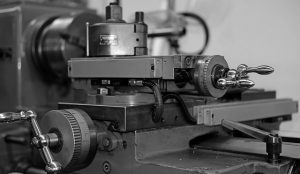
Lathes are an essential machining tool used in the manufacturing industry. Among other things, they support cutting, knurling, facing and turning operations. With origins dating back to Ancient Egypt, they are regarded as one of the oldest machining tools. So, how does a lathe work exactly?
The Basics of Lathes and How They Work
Although there are different types of lathes (see below), they all use a similar method in which the workpiece rotates against the cutting tool, the latter of which is stationary. Milling machines, of course, work in the opposite way. With a milling machine, the workpiece is stationary, whereas the cutting tool rotates.
Lathes are designed to remove material from workpieces by exposing them to a cutting tool. The workpiece is secured to the lathe, at which point it rotates while pressing into a cutting tool. The rotational movement of the workpiece allows for the fast, efficient and precise removal of material.
Lathes are large and complex machines consisting of many individual components. The headstock, for example, is the component that holds the workpiece as it rotates. Lathes also have a tailstock to which the workpiece can be secured. The tailstock is typically used for exceptionally large or long workpieces.
The Different Types of Lathes
There are nearly a dozen types of lathes, each of which are designed for a different purpose. Woodworking lathes live up to their namesake by supporting wooden workpieces. They typically operate at a speed of 5,00 to 1,000 revolutions per minute (RPM).
In addition to woodworking lathes, there are also metalworking lathes. Metals are generally harder than wood, so metalworking lathes require a stronger and sharper cutting tool than their woodworking counterparts. Metalworking lathes offer a range of different cutting tools, varying in size, shape and material, but they are all designed to cut through common metals like aluminum and steel.
A glass-working lathe, of course, is a type of lathe that’s used for glass workpieces. It’s used to make glasses and optical materials by exposing them to a stationary cutting tool. Of course, there are many other types of lathes, some of which include metal-spinning lathes, ornamental turning lathes, cue lathes and patternmaker’s lathes.
In Conclusion
A lathe is a machining tool that features a rotating workpiece and a stationary cutting tool. The workpiece is secured to the headstock or tailstock, which rotates the workpiece while it presses against a stationary cutting tool.
